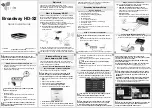
TK-3402/3406/3407
12
CIRCUIT DESCRIPTION
5-1. Frequency Shift Circuit
The MCU (IC702) and baseband IC (IC705) operates at
a clock frequency of 19.2MHz. This oscillator has a circuit
that shifts the frequency via Beat shift switch (Q701, Q702).
A beat sound may be able to be evaded from generation
if “Beat Shift“ is set to ON when it is generated in the internal
spurious transmission modulated sound of the transceiver.
IC705
Baseband IC
H: OFF
L: ON
X700
3
9
40
XTALN
XTAL
Q702
C72
9
IC702
MCU
14
12
BSHIFT
XIN
C725
Q701
R731
R743
C720
C724
R732
Fig. 7 Frequency shift circuit
5-2. Memory Circuit
The Memory circuit consists of the MCU (IC702) and EE-
PROM (IC700). The EEPROM has a capacity of 64k bits and
stores the channel information, the last channel data, the
scan on status, and other parameters.
■
EEPROM
Note:
The EEPROM stores tuning data (Deviation, Squelch,
etc.).
Realign the transceiver after replacing the EEPROM.
5-3. Low Battery Warning
The battery voltage is monitored by the MCU (IC702 pin
63: BATT). When the battery voltage falls below the voltage
set by the Low Battery Warning adjustment, the red LED
blinks, notifying the operator that it is time to replace the bat-
tery (when the always option (default setting) under the Bat-
tery Warning function in the FPU is selected). If the battery
voltage falls bellow 5.9V, the transceiver does not transmit
and the warning tone beeps while the PTT switch is pressed.
5-4. Key Input
Keys and channel selector circuit.
The signal from the keys and channel selector are direct-
ly input to the MCU, as shown in Figure 10.
EN4
EN3
Selector
IC702
MCU
Side1
Side2
PTT
SW
EN2
EN1
Side2
Side1
PTT
51
4
9
50
48
2
9
52
53
S1
Fig. 8 Key input
6. Signaling Circuit
6-1. Encode
■
Low-speed data (QT, DQT)
Low-speed data is output from pin2 of the MCU. The sig-
nal passes through the low pass CR fi lter, and goes to the
audio processor (IC705). The signal is mixed with the audio
signal and goes to the VCO and TCXO (X1) modulation in-
put after passing through the D/A converter inside the audio
processor (IC705) for BAL adjustment.
■
High-speed data (2-tone,5-tone)
High-speed data (HSD) is output from pin 3 of the MCU.
HSD deviation made by an adjustment in the MCU is passed
through the low pass CR fi lter and then applied to the base-
band IC (IC705).
The signal is mixed with the audio signal and goes to the
VCO and TCXO. The signal passes through low pass CR fi l-
ter and D/A converter, and goes to the audio power amplifi er.
The level is controlled by the MCU.
■
MSK/DTMF/MDC-1200
The MSK/DTMF/MDC-1200 signal is generated in the
audio processor (IC705). The signal passes through the D/
A converter (inside the baseband IC: IC705) and is routed
to the VCO. When encoding the MSK/DTMF/MDC-1200, the
microphone input signal is muted.
6-2. Decode
■
QT/DQT
The output signal from the IF IC (IC400) enters the MCU
(IC702) through IC705. IC702 determines whether or not
the QT or DQT matches the preset value, and controls the
AFSW and speaker output sounds according to the squelch
results.
■
2-tone/5-tone
Part of the received AF signal output from the IF IC (IC400)
passes through the baseband IC (IC705) is compared, and
then goes to MCU (IC702). IC702 checks whether or not the
2-tone/5-tone data is necessary. If it matches, IC702 carries
out a specifi ed operation, such as turning the speaker on.
■
MSK (Fleet Sync)
The MSK input signal from the IF IC (IC400) goes to
IC705. The decoded information is then processed by the
MCU.
■
DTMF/MDC-1200
The DTMF/MDC-1200 input signal from the IF IC (IC400)
goes to IC705. The decoded information is then processed
by the MCU.
Содержание TK-3402
Страница 42: ...TK 3402 3406 3407 ...













































